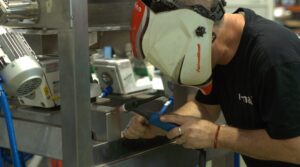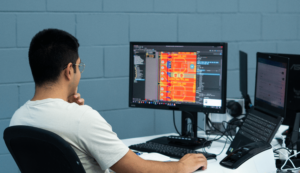In recent years, artificial intelligence (AI) has advanced dramatically in the industrial environment. From machine vision systems that detect defects invisible to the human eye to predictive maintenance algorithms that anticipate breakdowns before they occur, AI is transforming the way we design, produce and manage manufacturing plants. Applications such as industrial automation, collaborative robotics systems, deep learning in vision or autonomous industrial robots are already part of everyday life in many industrial processes.
However, despite these impressive capabilities, one question remains: can AI replace human intuition in the industrial arena?
Where does Artificial Intelligence excel?
Today’s industrial AI has clear advantages in multiple tasks within industrial processes. Some of the areas where it contributes most value are:
- Analysis of large volumes of data: thanks to IoT sensing, maintenance histories and production logs, algorithms can find patterns invisible to humans.
- Complex pattern recognition: with special effectiveness in artificial vision applied to quality control, defect detection and automatic classification of parts through deep learning.
- Automation of repetitive decisions: such as the adjustment of process parameters or the activation of protocols in industrial robots under certain input conditions.
- Optimization of predictive maintenance: anticipating failures before they occur, based on statistical analysis, modeling of historical data and real-time anomalous signals.
- Design and simulation assistance: through algorithms that propose improvements on FEM models or CFD simulations, accelerating structural design iterations.
In all these applications, AI clearly outperforms humans in speed, computing power, consistency and response to repetitive or real-time tasks.
Current limitations of Artificial Intelligence
Despite its advantages, industrial AI has relevant limitations:
- Lack of context: AI models operate within the boundaries of the data they have been trained on. If conditions change or there is an unrecorded anomaly, the system may fail or make erroneous decisions.
- Causal reasoning: current AI is very good at recognizing correlations, but has difficulty establishing cause-effect relationships in complex environments.
- Explainability: in many cases, models (such as deep neural networks) cannot explain why they have made a decision, which generates distrust in critical environments.
- Intuitive adaptability: AI does not improvise well. A human can adapt a process on the fly using experience and intuition. AI, unless it has been specifically trained for that case, will not.
The future of Industrial AI: collaboration, not replacement
Rather than thinking of AI as a substitute for humans, it is more realistic (and productive) to see it as a tool that enhances their capabilities. The combination of AI and human intuition opens the door to more efficient, safer and resilient industrial environments.
For example, a machine vision system may detect 95% of defects, but the remaining 5% may require human review. Or a predictive system may anticipate a failure, but it is an experienced technician who determines when and how to intervene.
In short, AI cannot yet replace that form of tacit, instinctive and contextual knowledge that defines the great professionals of the industrial environment. But it can be their best ally.
In the engineering department of I-MAS we apply methodologies based on more than 20 years of experience in industrial automation and machine vision, integrating Deep Learning models in different industrial processes. This approach allows transforming advanced technologies into applied solutions, improving productivity, reducing errors and optimizing traceability and plant control.
Want to learn more about our services? Contact us or visit our projects section!



